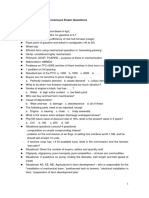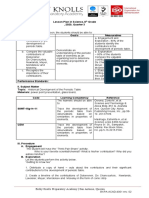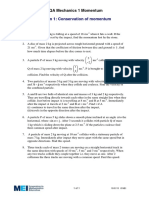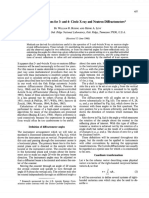Projectile Motion
Uploaded by
wolfretonmathsProjectile Motion
Uploaded by
wolfretonmathsAQA Mechanics 1 Projectiles
Section 1: Projectile motion
Notes and Examples
These notes contain subsections on
Investigating projectiles
Modelling assumptions
General strategy for projectile questions
Components of the velocity
Finding the time of flight, range and maximum height
Height of projection
The equation of the path of a projectile (extension)
Investigating projectiles
There are several resources on the website which allow you to investigate
projectiles. It is worth trying some of these before working through the
chapter, to give yourself a feel for the topic.
The Component interactive spreadsheet allows you to investigate the flight
of a projectile as the vertical and horizontal components of the velocity vary.
The Angle interactive spreadsheet allows you to investigate how varying
the angle of projection affects the range of the projectile.
The Projectiles interactive spreadsheet allows you to view the path of a
projectile for which you can set the initial velocity, the angle of projection and
the initial height.
The Projectiles application provides four different activities: two
investigations and two worked examples..
Modelling assumptions
The modelling assumptions for projectile motion:
the object is a particle
the only force acting is gravity (so there is no air resistance)
the ground is a horizontal plane
are very important. Without them, analysing projectiles would be much
harder. In many situations these assumptions will not make a significant
difference to the final answer, so they are reasonable. However, throwing a
flat sheet of paper, for example, could not usefully be analysed without taking
account of the effects of air resistance.
1 of 10
10/01/13 MEI
AQA M1 Projectiles 1 Notes and Examples
General strategy for projectile questions
Splitting the velocity into two components, horizontal and vertical, is the
standard way to solve projectiles questions.
The equations of motion are then applied to each component of velocity. The
main ones used are:1
v u at and s ut at 2
2
y
V
The diagram shows
the path of a projectile
with initial velocity V,
projected at angle to
the horizontal.
x
vertical velocity
(using v u at )
vertical displacement
(using
s ut 12 at 2 )
Vertically
ay g
Horizontally
ax 0
u y V sin
ux V cos
vy V sin gt
vx V cos
y Vt sin 12 gt 2
x Vt cos
where t is the time of flight.
horizontal velocity
(using v u at )
horizontal displacement
2
(using s ut 12 at )
Sometimes it may be more efficient to work in vector form, so that you are
dealing with the vertical and horizontal motion at the same time.
Applying the vector equation v u at gives
V cos 0
v
t
V sin g
Applying the vector equation s ut 12 at 2 gives
V cos 1 0 2
s
t t
V sin 2 g
Using column vectors rather than the ai + bj form of a vector is often clearer
since you can then read each separate equation off.
Components of the velocity
The vertical component
When the vertical component of velocity is positive, the particle is rising.
2 of 10
10/01/13 MEI
AQA M1 Projectiles 1 Notes and Examples
At the instant the vertical component of velocity is 0, the particle is at
maximum height.
When the vertical component of velocity is negative, the particle is falling.
The horizontal component
Remember: THE HORIZONTAL VELOCITY REMAINS CONSTANT.
It is worth noting that a particle which is fired from the top of a cliff at
100 ms-1 horizontally and another which is dropped from the top of the
same cliff at the same time will land on the ground at the same time! This
is because they both have an initial vertical component of velocity of
0 ms-1. Their initial horizontal components of velocity will have no effect
on their motion in the vertical direction.
Direction of flight
The direction of flight depends upon the ratio of the horizontal and vertical
velocities.
As the horizontal velocity remains constant, the direction of flight changes
because of the change in the vertical velocity.
The direction of flight can be obtained by combining the velocity
components in the usual way:
V
vy V sin
tan
vy
vx
vx V cos
Finding the time of flight, range and maximum height
Time of flight
The time of flight can be found in two ways: Use v 0 in v u at to find the time to maximum height, and then
double it. This only works if the starting and finishing points are on the
same level.
1
Put y = h in s ut at 2 , where h is the vertical displacement from its
2
starting point when the particle lands, then solve this quadratic to give
t. If the projectile starts and stops at the same level, h = 0. There will be
two solutions to the quadratic, but the time when the particle lands
must be the greater (think about why this is the case).
Range
The range is found by multiplying the time of flight with the horizontal
component of the velocity.
(Remember, for a projectile, the horizontal component of velocity is
CONSTANT).
3 of 10
10/01/13 MEI
AQA M1 Projectiles 1 Notes and Examples
It may be stating the obvious, but the range is always increasing whilst the
particle is off the ground.
Maximum height
At the maximum height, the vertical component of velocity is 0, so use v 0 in
v2 u 2 2as to get the maximum height and in v u at to get the time to
maximum height.
Note that you must NOT quote formulae for the range, time of flight or
maximum height of a projectile. In an examination you will be required to
show that you can find them using the ideas above.
Example 1
A projectile is fired with an initial speed V from a point O on a horizontal plane, the
angle of elevation being tan 1 23 . The particle returns to the plane at a point A. Find
the distance OA, in terms of V. Show that the same point could have been reached by
firing the particle at the same speed from O, but at an angle of elevation tan 1 32 .
Find, in terms of V, the difference in the times of flights of the two trajectories.
Solution
V
Notice how you can use
Pythagorass theorem to find the
sine and cosine of an angle if you
know its tangent as a fraction.
13
2
2
2
3
tan , sin
, cos
3
3
13
13
To find the time of flight, since the particle lands on the same level as it started, we
can find the time to maximum height and then double it:
Vertically:
2
V
13
v 0 (at max height)
a 9.8
t ?
u V sin
v u at
2V
0
9.8t
13
2V
t
9.8 13
4 of 10
Alternatively, put y = 0
in the equation
y ut sin 12 gt 2
10/01/13 MEI
AQA M1 Projectiles 1 Notes and Examples
The time of flight is double this,
4V
so the time of flight is t
0.113V seconds (3 s.f)
9.8 13
The horizontal range is the value of x when t takes the above value.
x Vt cos
4V
3
V
9.8 13
13
2
12V
9.8 13
0.094V 2 (3 d.p.)
If the particle is projected at the same speed, V, but at angle , such that tan
3
,
2
then:
13
3
3
3
2
tan , sin
, cos
2
13
13
2
To find the time of flight, find the time to maximum height and then double it, as
before:
Vertically:
3
V
13
v 0 (at max height)
a 9.8
t ?
u V sin
v u at
3V
0
9.8t
13
3V
t
9.8 13
The time of flight is double this,
6V
0.170V seconds (3 s.f).
So the time of flight is
9.8 13
The horizontal range is the value of x when t takes the above value.
x Vt cos
6V
2
V
9.8 13
13
2
12V
9.8 13
0.094V 2 (3 d.p.)
So the ranges are the same.
5 of 10
10/01/13 MEI
AQA M1 Projectiles 1 Notes and Examples
The difference in the times of flight is
6V
4V
2V
0.0566V seconds
9.8 13 9.8 13 9.8 13
(3 s.f.)
Height of projection
If the object is not projected from ground level, then you need to be careful to
include the initial height in your equations.
Example 2
4
A ball is projected with a velocity from a position
5
find:
(i)
the maximum height,
(ii)
the time of flight,
(iii) the range,
(iv)
the angle of flight after 1 second.
0
. Assuming g = 10ms-2
10
The curved line
shows the path of
the projectile
-1
5ms
4ms-1
10m
Solution
(i)
At the maximum height, the vertical velocity is 0.
So, using the equation v 2 u 2 2as
02 52 2(-10) s
25
s
1.25
20
So the maximum height is 1.25 m above the starting point, 11.25 m above the
ground.
(ii)
The time of flight can be obtained using s ut 12 at 2 , considering the vertical
motion of the projectile. Here s will be 10 m, as we want the time when the
particle hits the ground. At this time the particle is 10 m below the starting
point.
6 of 10
10/01/13 MEI
AQA M1 Projectiles 1 Notes and Examples
s ut 12 t 2
10 5t 12 10 t 2
5t 2 5t 10 0
5 t 1 t 2 0
So t 1 , which is impossible, or t 2 .
The time of flight is 2 seconds.
(iii)
The range is just the horizontal velocity, which remains constant, multiplied
by the time of flight.
So the range is 4 2 = 8 m
(iv)
The direction of the flight is given by the ratio of the velocities.
After 1 second, the vertical velocity is found using v = u + at
v 5 (10) 1
v 5
The horizontal velocity is still 4 ms-1. It does not change.
4 ms-1
Angle of flight:
5
tan A
4
A 51.3 (3s.f.)
A
5 ms-1
So, after 1 second, the direction of flight is 51.3 (3 s.f.) below the horizontal.
Example 3
A boy throws a ball horizontally from a point 5.1 m above the horizontal ground.
(i)
What is the minimum speed at which the ball must be thrown to clear a fence
2.6 m high at a horizontal distance of 8 m from the point of projection?
(ii)
Find the distance beyond the fence at which the ball strikes the ground if it is
projected at this speed?
Solution
Path of projectile
5.1m
2.6m
8m
7 of 10
10/01/13 MEI
AQA M1 Projectiles 1 Notes and Examples
(i)
In the time the ball travels 8 m horizontally, it must fall a maximum distance
of 5.1 2.6 = 2.5 m if it is to clear the fence.
Considering the vertical motion:
The time to fall 2.5 m:
u 0
a 9.8 ms 2
s 2.5 m
t ?
1
s ut at 2
2
2.5 4.9t 2
t 0.714 sec onds (3 s.f.)
So the ball travels 8 m horizontally in 0.714 s,
8
so its initial horizontal speed is
= 11.2 ms-1 (3 s.f.), or greater.
0.714
(ii)
The time for the ball to fall to ground level is found as above, except that now
s = 5.1 m, instead of 2.5 m.
5.1
So 5.1 4.9t 2 t
1.02s (3 s.f.)
4.9
In 1.02 seconds the ball will travel 1.02 11.2 11.42m (4 s.f.) horizontally,
so it will land 11.42 - 8 = 3.42 m (3 s.f.) beyond the fence.
The equation of the path of a projectile (extension)
If you eliminate the t variable from the equations for vertical displacement (y)
and horizontal displacement (x), you get a Cartesian equation, which gives
you the projectiles path (its trajectory) through the air.
The path equation can be very useful. It gives you a way of identifying each
point on the trajectory easily.
Example 4
A particle is projected from a point 1 m above the ground, with initial velocity of
10 ms-1 at an angle above the horizontal, where cos 0.8 and sin 0.6 . The
origin is taken to be the point on the ground directly below the point of projection.
(i)
Find equations for the horizontal and vertical positions, x m and y m, in terms
of t.
(ii)
Find the Cartesian equation of the path of the particle.
(iii) Find the value of y when x is 2.
(iv)
Find the possible values of x when y is 2.
Solution
(i)
The initial horizontal speed of the particle is 10cos 10 0.8 8
Horizontally the speed is constant
so x 8t
8 of 10
10/01/13 MEI
AQA M1 Projectiles 1 Notes and Examples
The initial vertical speed of the particle is 10sin 10 0.6 6
The vertical displacement is given by s ut 12 at 2
6t 12 10t 2
6t 5t 2
The initial height is 1 m
so y 1 6t 5t 2
(ii)
x
8
Substituting into y 1 6t 5t 2 :
x 8t t
6x
x
y 1
5
8
8
3
5
y 1 x x2
4
64
(iii)
(iii)
3
5
When x = 2, y 1 2 22
4
64
3 5
1
2 16
2.1875
3
5
x x2
4
64
5 2 3
x x 1 0
64
4
2
5 x 48 x 64 0
( x 8)(5 x 8) 0
x 8 or x 1.6
When y = 2, 2 1
In the same way, it is possible to find the general equation for the path of a
projectile in terms of its initial velocity V and angle of projection :
x Vt cos
x
V cos
(1)
y Vt sin 12 gt 2
(2)
Substituting (2) into (1):
2
x
x
y V sin
12 g
V cos
V cos
yx
sin
gx 2
2
cos 2V cos 2
9 of 10
10/01/13 MEI
AQA M1 Projectiles 1 Notes and Examples
Using some trigonometry identities which you may or may not know, this gives
gx 2
y x tan 2 1 tan 2
2V
sin
tan
cos
1
1 tan 2
2
cos
This equation can easily be adapted to deal with a situation in which the
particle starts at a height h:
gx 2
y h x tan 2 1 tan 2
2V
Notice that these equations are quadratic in both and x. This means that
for each possible point on a projectiles path, for every initial velocity there are
two angles which will result in the projectile passing through the point, except
at maximum range (for a quadratic equation, for all y values, except the
maximum (or minimum) point, there are two possible x values think about
the graph of a quadratic)
You should NOT attempt to learn or quote this equation.
There are usually two ways of hitting a point with a given initial speed.
One path has a low trajectory and a short time of flight, whereas the other has
a much higher trajectory and a longer time of flight.
y
This point is on both trajectories.
For a given initial speed, one has a
steep angle of projection, the other
is much shallower.
10 of 10
10/01/13 MEI
You might also like
- Using Parametric Equations - Solutions PDFNo ratings yetUsing Parametric Equations - Solutions PDF4 pages
- ITEM-ANALYSIS With Most and Least Learned Skills100% (12)ITEM-ANALYSIS With Most and Least Learned Skills12 pages
- Laboratory Module 1 - Work and Energy Assignment Sheet50% (2)Laboratory Module 1 - Work and Energy Assignment Sheet7 pages
- Kinematics Practice Test: Section A. Multiple Choice Questions (10 Marks)No ratings yetKinematics Practice Test: Section A. Multiple Choice Questions (10 Marks)6 pages
- Worksheet - Projectile Motion 1 SolutionNo ratings yetWorksheet - Projectile Motion 1 Solution6 pages
- The Ubiquitous Matched Filter A Tutorial and Application To Radar DetectionNo ratings yetThe Ubiquitous Matched Filter A Tutorial and Application To Radar Detection18 pages
- Session 6: Circular Motion and Gravitation: Multiple ChoiceNo ratings yetSession 6: Circular Motion and Gravitation: Multiple Choice4 pages
- Universe Question Bank (Introduction) : Physics Physics100% (1)Universe Question Bank (Introduction) : Physics Physics2 pages
- Physics 114 - Graphical Analysis of Motion 2015-2No ratings yetPhysics 114 - Graphical Analysis of Motion 2015-24 pages
- 60 Questions Basic Physics Paul G Hewitt PDFNo ratings yet60 Questions Basic Physics Paul G Hewitt PDF9 pages
- Science11 - Q1 - Mod1 - GeneralBiology1-Part 1No ratings yetScience11 - Q1 - Mod1 - GeneralBiology1-Part 138 pages
- Simple Harmonic Motion Unit Plan 2014-03-26No ratings yetSimple Harmonic Motion Unit Plan 2014-03-263 pages
- Worksheet - 5 - SHM - Springs and Pendulums KeyNo ratings yetWorksheet - 5 - SHM - Springs and Pendulums Key3 pages
- Multiple Choice (2 Points Each) : Astronomy Unit Test100% (1)Multiple Choice (2 Points Each) : Astronomy Unit Test6 pages
- Mechanical Waves Like A. - , Water Waves, Earthquake Waves, and Waves in A StretchedNo ratings yetMechanical Waves Like A. - , Water Waves, Earthquake Waves, and Waves in A Stretched2 pages
- Electric Potential Energy and Electric PotentialNo ratings yetElectric Potential Energy and Electric Potential12 pages
- Mathematics Applied 4 Projectiles Year 13 Term 2No ratings yetMathematics Applied 4 Projectiles Year 13 Term 22 pages
- Using Partial Fractions in Integration Exercise PDFNo ratings yetUsing Partial Fractions in Integration Exercise PDF1 page
- Vectors in Two & Three Dimensions Exercise PDFNo ratings yetVectors in Two & Three Dimensions Exercise PDF2 pages
- Angle Calculations For 3-And 4 - Circle X-Ray and Neutron DiffraetometersNo ratings yetAngle Calculations For 3-And 4 - Circle X-Ray and Neutron Diffraetometers8 pages
- D - Solving A Triangle With The Law of Cosines0% (1)D - Solving A Triangle With The Law of Cosines3 pages
- Type I: Examples Based On Components in Space100% (1)Type I: Examples Based On Components in Space13 pages
- AP Inter 2nd Year Syllabus 2020-21 - MATHEMATICS - 2B100% (1)AP Inter 2nd Year Syllabus 2020-21 - MATHEMATICS - 2B3 pages
- Mathematics Grades I-X Approved by BOG 66No ratings yetMathematics Grades I-X Approved by BOG 66118 pages
- Parts of Circles (Read) Geometry CK-12 FoundationNo ratings yetParts of Circles (Read) Geometry CK-12 Foundation1 page
- B.E. 301 - Engineering Mathematics Ii Unit INo ratings yetB.E. 301 - Engineering Mathematics Ii Unit I2 pages
- 1 Accurate Algorithms To Transform Geocentric To Geodetic Coordinates (Borkowski 1989)No ratings yet1 Accurate Algorithms To Transform Geocentric To Geodetic Coordinates (Borkowski 1989)7 pages
- Laboratory Module 1 - Work and Energy Assignment SheetLaboratory Module 1 - Work and Energy Assignment Sheet
- Kinematics Practice Test: Section A. Multiple Choice Questions (10 Marks)Kinematics Practice Test: Section A. Multiple Choice Questions (10 Marks)
- The Ubiquitous Matched Filter A Tutorial and Application To Radar DetectionThe Ubiquitous Matched Filter A Tutorial and Application To Radar Detection
- Session 6: Circular Motion and Gravitation: Multiple ChoiceSession 6: Circular Motion and Gravitation: Multiple Choice
- Universe Question Bank (Introduction) : Physics PhysicsUniverse Question Bank (Introduction) : Physics Physics
- Multiple Choice (2 Points Each) : Astronomy Unit TestMultiple Choice (2 Points Each) : Astronomy Unit Test
- Mechanical Waves Like A. - , Water Waves, Earthquake Waves, and Waves in A StretchedMechanical Waves Like A. - , Water Waves, Earthquake Waves, and Waves in A Stretched
- Using Partial Fractions in Integration Exercise PDFUsing Partial Fractions in Integration Exercise PDF
- Angle Calculations For 3-And 4 - Circle X-Ray and Neutron DiffraetometersAngle Calculations For 3-And 4 - Circle X-Ray and Neutron Diffraetometers
- AP Inter 2nd Year Syllabus 2020-21 - MATHEMATICS - 2BAP Inter 2nd Year Syllabus 2020-21 - MATHEMATICS - 2B
- 1 Accurate Algorithms To Transform Geocentric To Geodetic Coordinates (Borkowski 1989)1 Accurate Algorithms To Transform Geocentric To Geodetic Coordinates (Borkowski 1989)
















































































































